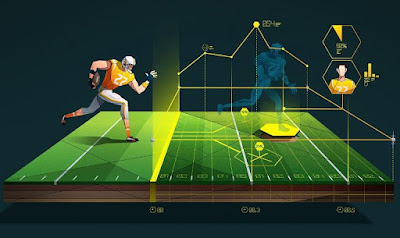Revolutionizing the Game: How Technology is Transforming the World of Sports
Technology on Sports have always been a captivating aspect of human culture, showcasing the indomitable spirit of competition, athleticism, and the pursuit of excellence. Over the years, the influence of technology on sports has been nothing short of revolutionary. From performance analytics to fan engagement, technology has significantly enhanced various aspects of the sporting world, elevating both the players' performances and the spectators' experience.Performance Analytics: Unleashing the Power of Data
In the modern era of sports, data has become a game-changer. Advanced technologies enable the collection and analysis of vast amounts of data, providing invaluable insights into athletes' performance, training methods, and overall strategies. Performance analytics has become a cornerstone of sports, empowering athletes and coaches to make more informed decisions, identify areas for improvement, and optimize training regimes.
Through the utilization of cutting-edge sensors and wearables, athletes can track their vital statistics, such as heart rate, speed, and distance covered. This real-time data allows for personalized training programs tailored to individual strengths and weaknesses. Furthermore, performance analytics help teams identify patterns, analyze opponents' tactics, and devise winning strategies.
The Evolution of Sports Tech: Enhancing Equipment
Technology has revolutionized sports equipment, pushing the boundaries of performance and safety. Innovative materials, engineering advancements, and meticulous design have resulted in equipment that maximizes athletes' potential while minimizing the risk of injuries.
In sports such as golf, tennis, and baseball, the introduction of smart sensors has transformed the way athletes interact with their equipment. These sensors provide precise measurements, analyzing swing mechanics, ball trajectory, and impact dynamics. The data collected assists players in refining their techniques, optimizing their swings, and gaining a competitive edge.
Moreover, sports like basketball and soccer have embraced smart technologies to enhance player safety. Impact-absorbing materials, shock-resistant padding, and intelligent gear contribute to reducing the risk of concussions and other injuries. Sports tech has become an invaluable ally in protecting athletes and prolonging their careers.
Engaging the Fans: Immersive Experiences
Technology has ushered in an era of unprecedented fan engagement, bringing spectators closer to the action than ever before. Through immersive experiences, augmented reality (AR), and virtual reality (VR), fans can delve into the heart of the game, blurring the line between reality and digital realms.
AR and VR technologies transport fans to the stadiums virtually, allowing them to witness the intensity and grandeur of live sporting events from the comfort of their homes. Spectators can explore interactive 3D models of sports venues, view real-time statistics, and even experience a player's perspective through 360-degree videos. These immersive experiences create a sense of involvement and excitement, captivating fans worldwide.
Social media platforms have also played a significant role in revolutionizing fan engagement. Fans can connect with their favorite teams, athletes, and fellow enthusiasts, sharing their passion and insights in real-time. Live streaming, interactive polls, and behind-the-scenes content enable fans to be a part of the sports community like never before.
The Benefits of Technology in Sports
The integration of technology in sports offers numerous benefits that extend beyond performance and fan engagement. Let's explore some of these advantages:
Injury Prevention and Rehabilitation
Technology aids in injury prevention by providing athletes with real-time feedback on their movements and technique. Biomechanical sensors and motion capture systems can detect potential injury risks, allowing athletes to make necessary adjustments to avoid harm. Additionally, advanced rehabilitation tools, such as electromagnetic therapy and virtual reality-assisted recovery programs, accelerate the healing process and optimize rehabilitation outcomes.
Training Optimization and Performance Enhancement
With the help of technology, athletes can analyze their performance data, identify areas for improvement, and refine their training programs accordingly. Virtual training simulations allow athletes to practice and perfect their skills in a controlled environment. Performance-tracking devices offer instant feedback, enabling athletes to make immediate adjustments and reach peak performance levels.
Accessible Sports for All
Technology has opened doors for individuals with disabilities to actively participate in sports. Innovations like assistive exoskeletons, adaptive equipment, and specialized wheelchairs empower disabled athletes to engage in various sports, promoting inclusivity and fostering a sense of community.
Spectator Involvement and Global Reach
The integration of technology in sports has transcended geographical boundaries, allowing fans worldwide to connect and engage with their favorite sports and athletes. Live streaming platforms, social media interactions, and interactive apps bridge the gap between cultures and unite sports enthusiasts from different corners of the globe.
conclusion
In conclusion, the influence of technology on sports has transformed the way we play, watch, and engage with our favorite games. From performance analytics that provide valuable insights into athletes' performance to the development of advanced sports equipment and the creation of immersive fan experiences, technology has revolutionized the sporting world. The benefits are vast, including injury prevention, enhanced training and performance, accessibility for all, and increased global reach. As technology continues to evolve, we can expect even more remarkable advancements that will further enhance the world of sports and provide new opportunities for athletes and fans alike. Embracing the power of technology, sports will continue to evolve and captivate us in ways we could have never imagined.FAQ
1. How does technology contribute to improving athletes' performance in sports?
- Technology enhances athletes' performance in sports by providing valuable data through performance analytics. Athletes can track vital statistics such as heart rate, speed, and distance covered, enabling personalized training programs and identifying areas for improvement. Moreover, advanced technologies help teams analyze opponents' tactics, leading to better strategies and decision-making.
2. What are some examples of sports tech innovations that have revolutionized equipment?
- Sports tech innovations have revolutionized equipment in various sports. For example, smart sensors in golf clubs, tennis rackets, and baseball bats provide precise measurements, allowing players to analyze their techniques and optimize their swings. Additionally, impact-absorbing materials and intelligent gear in sports like basketball and soccer reduce the risk of injuries, ensuring player safety.
3. How do immersive experiences like augmented reality (AR) and virtual reality (VR) enhance fan engagement in sports?
- Immersive experiences like augmented reality (AR) and virtual reality (VR) revolutionize fan engagement by bringing them closer to the game. Through AR and VR technologies, fans can virtually experience live sporting events, explore interactive 3D models of stadiums, access real-time statistics, and even view the game from a player's perspective through 360-degree videos. These immersive experiences create a more engaging and thrilling connection between fans and their favorite sports.
4. What are the benefits of using technology in sports for injury prevention and rehabilitation?
- Technology plays a crucial role in injury prevention and rehabilitation in sports. Biomechanical sensors and motion capture systems provide real-time feedback on athletes' movements, helping detect potential injury risks and allowing them to make necessary adjustments. Furthermore, advanced tools like electromagnetic therapy and virtual reality-assisted recovery programs accelerate the healing process and optimize rehabilitation outcomes, aiding athletes in their journey back to peak performance.
5. How has technology made sports more inclusive and accessible for individuals with disabilities?
- Technology has made sports more inclusive and accessible for individuals with disabilities. Innovations such as assistive exoskeletons, adaptive equipment, and specialized wheelchairs enable disabled athletes to actively participate in various sports, breaking down barriers and promoting inclusivity. These advancements empower individuals with disabilities to engage in sports and experience the joy of competition, fostering a sense of community and expanding opportunities for all athletes.







0 Comments